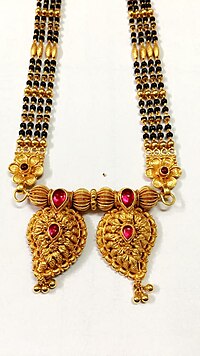Mangala sutra

This article needs additional citations for verification. (October 2011) |

A mangala sutra (IAST: maṅgala sūtra), or thaali (ISO: tāḷi), is a necklace that the groom ties around the bride's neck in the Indian subcontinent, in a ceremony called Mangalya Dharanam (Error: {{language with name/for}}: missing language tag or language name (help)). The necklace serves as a visual marker of status as a married Hindu woman. [1]
Mangala sutra's origin dates back to the 6th Century AD as a single yellow thread was tied around the bride for protection from other men and evil spirits. Mangala sutra is a social practice widespread in India, Sri Lanka, and Nepal. The term mangala sutra in Sanskrit means holy thread.
Overview
Mangala sutram literally means "an auspicious thread" which is knotted around the bride's neck. It is usually a necklace with black beads strung from a black or yellow thread prepared with turmeric. Sometimes gold, white or red beads are also added to the mangala sutram, depending on regional variation. It is a symbol of marriage worn by women. The idea of sacred thread existed for centuries, even going back to Sangam period. But the nature of these auspicious threads have evolved over time, and varies widely according to various communities. Non-Hindu religious groups such as Syrian Christians also wear mangal sutra, but with a cross on it. There are many communities in India, among whom the mangal sutra seems to be absent, and other forms of marital tokens have taken their place. For example, in large parts of North India, the toe ring and glass bangles indicate the marital status of a woman.
Historian of Indian jewellery, Dr. Usha Balakrishnan explains that the practice of ritualistically adorning the bride with a mangal sutra to solemnise marriage, is a modern concept, made possible due to marketing strategies of businesses. She also says that,
“There was no concept in ancient India of a marriage being solemnised through a mangal sutra as we know of it today with diamonds, pendants and the like,”[2]
The concept of mangal sutra has evolved over centuries, and has become an integral part of marriages among several Indian communities.
Significance
The significance of the mangala sutra was re-iterated by Adi Shankara in his famous book Soundarya Lahari. According to Hindu tradition, the mangala sutra is worn for the long life of the husband. As told by religious customs and social expectations, married women should wear mangala sutra throughout their life as it is believed that the practice enhances the well-being of her husband. Bridal jewellery in ancient times also worked as a financial security against old age and widowhood, as women did not have any property rights.[2]
In different languages
It is called thaali (தாலி) or maangalyam (மாங்கல்யம்) in Tamil, nuptial chain in English, thella (තැල්ල) in Sinhala, mongolsutro (মঙ্গলসূত্র) in Bengali, mangal sutra (मंगळसूत्र) in Marathi, mangalyasutra (ಮಾಂಗಲ್ಯ ಸೂತ್ರ), thaali (ತಾಳಿ) in Kannada, and thaali (తాళి), maangalyamu (మాంగళ్యము), mangalasutramu (మంగళసూత్రము) or pustelu (పుస్తెలు) in Telugu, thaali (താലി) in Malayalam, Mangalasutra (ମଙ୍ଗଳସୂତ୍ର) in Odia, Konkani people (Goans, Mangaloreans, East Indians and others, including Hindus ) wear three necklaces around their necks, referred to as dhaaremani or muhurtmani (big golden bead), mangalasutra with one or two gold discs and kasithaali with gold and coral beads. In Andhra Pradesh and Telangana regions, the two coin-sized gold discs are separated by 2-3 beads of different kinds. By tradition, one disc comes from the bride's family and another from the groom's side.[3]
Designs
Mangala sutras are made in a variety of designs. The common ones are the Lakshmi thaali, pustelu worn by the Telugus, ela thaali or minnu worn by the Malayalees, and the kumbha thaali worn by the tamilians of the Kshatriya caste. The design is chosen by the groom's family according to prevalent customs. Gujaratis and Marwaris often use a diamond pendant in a gold chain which is merely ornamental in nature and is not a substitute to the mangala sutra in the traditional sense. Maharashtrians wear a pendant of two vati ornaments. The mangalya, thaali or mangala sutra of Kannadigas is similar to that of the Maharashtrians, except that it usually has two vatis. Nowadays many fashion conscious families opt for lighter versions, with a single vati or more contemporary style.
Gallery
-
Traditional Mangalasutram in Andhra Pradesh
-
Thaali with cross of 21 beads used by Saint Thomas Christians of Kerala.
-
Pillayar Thali
-
Thamarai Thali
-
Thennaimarathali
-
Thaali
-
Kongu Vellala Gounder Thaali
-
Devi Mangala sutra
See also
References
- ^ Subhamoy Das. "Mangalsutra Necklace - Hindu Symbol of Love & Marriage". About.com Religion & Spirituality. Archived from the original on 13 May 2016. Retrieved 8 May 2016.
- ^ a b "How the concept of Mangal Sutra has evolved over the centuries". The Indian Express. 5 November 2021. Retrieved 5 November 2021.
- ^ "Mangalsutra From Different States of India". KuberBox Jewellery Blog. 27 May 2016. Retrieved 2 December 2020.
Sources
- "An Ornament of Beauty," by Ganesh Joshi published in Woman's Era, January 2007.








